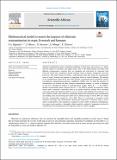| dc.description.abstract | Aflatoxin contamination poses a significant challenge in food safety and security as it affects
both the health of consumers and supply chains. Due to the health impacts associated with
aflatoxin contamination, countries have set standards and restrictions for importing food
crops and animal feed, resulting in greater economic losses to farmers, transporters, and crop
processors. This study aimed to develop a mathematical model that tracks the contamination
status of crops, livestock and humans in supporting efforts to control aflatoxin. The analysis
of the mathematical model shows that both aflatoxin contamination-free equilibrium (ACFE)
and aflatoxin contamination-persistence equilibrium (ACPE) exist. To study the dynamics of
contamination, we derived the basic aflatoxin contamination number, 𝑅0 which is analogous
to the basic reproduction number in epidemiological models. When 𝑅0 < 1, the ACFE is
globally asymptotically stable, whereas when 𝑅0 > 1 the ACPE is globally asymptotically stable.
Partial Rank Correlation Coefficients (PRCCs) for global sensitivity analysis were calculated
using Latin Hypercube Sampling (LHS) to see how sensitive and significant the parameter is on
each variable. Results from numerical simulations showed that decreasing crop contamination
and shading rates and increasing the death rate of aflatoxin fungi in soil by 50% can reduce
the basic contamination number by above 92%. Thus, it is important to introduce control
measures that target crop contamination, shading and death rates of aflatoxin fungi in soil to
reduce contamination in the population. Compared to other studies in aflatoxin contamination,
the current study provides a thoroughly global sensitivity analysis of parameters involved in
contamination and indicated the most important ones for control strategies | en_US |

